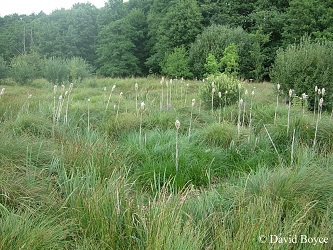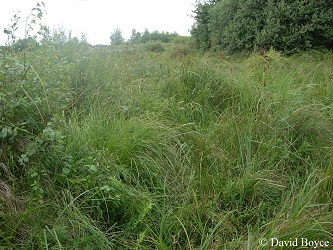Current ISIS code: W313
Previous assemblage name: W125 tussock fens with moss edges.
Linked assemblage: W314 reed-fen & pools.
Description of habitat typically supporting the assemblage: This assemblage type is mainly characterised by water beetles, but also by terrestrial beetles and two-winged flies.
The separation of W313 and W314 assemblages is supported by multivariate analysis of samples taken in appropriate habitats. W313 assemblages appear to avoid open water and require tussocks and/or isolated bushes for shelter. They are best expressed in permanently wet habitats.

In rich fen areas such as the Broads, this assemblage type is found in the middle of fen compartments, where the habitat is buffered against nutrient enrichment by river water. The habitat is often somewhat neglected with incipient shrubs, though not usually completely shaded out. Sphagnum is invariably present often with tussocks of Carex species.

Water quality is clearly a critical factor and the assemblage type is also found in spring-fed fens as well as in a variety of sites in the north and west where it can occur independently of rich fen. It has a discontinuous distribution and the best examples occur in sites with a long history of ecological continuity such as pingo systems. Many of the water beetles are found in saturated moss and tussocks with little free water above the surface. Schistoglossa species are often associated with emergent tussocks.
Potentially important environmental impacts
- Siltation and nutrient enrichment by surface run-off or inundation from polluted streams and rivers.
- Succession to carr and “terrestrialisation”.
- Interruption of ground water source.
Sampling & assessing the assemblage
Standard sampling protocols apply
Target groups: aquatic species, Coleoptera, Diptera
Fieldwork methods: ground-searching, sweep-netting
Alternative methods: passive trap methods.
Season:Later spring and summer
Pitfalls, water traps and malaise traps can be deployed as fixed effort assessments for assemblages here, though flooding issues may compromise pitfall grids. Trap data can be combined to better see spatially which assemblage occurs where, and possibly where the “strength” is on site.
Discrimination of conservation quality: good
Default target: 6 species
